
|
 |
On this page you can find
some of the answers for the questions of the exam; in some cases,
the answers are not complete, since you should be able to work them
out for yourselves—but the hints given here should tell you
just what would be an appropriate answer and what would not be. All
questions were equal in value and the best 6 questions you answered
were counted into the final grade.
| Q1 |
This question is about what you can do with a
particular grammar. The grammar is given for the question and
so you should not change it. You should only change a grammar
in a question if you are explicitly told do.
(a) there is only one rule that illustrates direct recursion,
that is, a rule that has on its righthand side an occurence
(in brackets or not) of the symbol that occurs on the lefthand
side, and that is rule (ii). Recursion is also created indirectly
by going from NP to PP and within PP to NP, but that is not
direct recursion.
(b) The example sentence: "On rainy days the farmer chases
the ducklings" obviously cannot be generated with the given
grammar as it begins with a prepositional phrase and there is
no combination of rules in the grammar that can lead to a prepositional
phrase being at the front.
If you attempt to create a sentence that is closest to the
given one ideationally, this means that you are not allowed
to change the Process, Participants and Circumstances. The only
way you can do this is by changing the word order, so the prepositional
phrase 'On rainy days' has to move. Note that the grammar is
also not able to produce 'on rainy days', because the Determiner
is obligatory in the NP rule. This is OK in that it does not
change the ideational meaning particularly but you would need
to make this change for full marks here. The grammar does not
produce 'on rainy days' and you should not change it. This gives
the sentence "The farmer chases the ducklings on the rainy
days".
If we put the PP at the end of the sentence, then there are
two syntactic trees that the given grammar can produce to cover
the sentence (this is then one answer to part (d) of this question).
Only one of these is appropriate as an answer
to this question however, since only one of these would have
the prepositional phrase as a Circumstance. This is the tree
shown here:
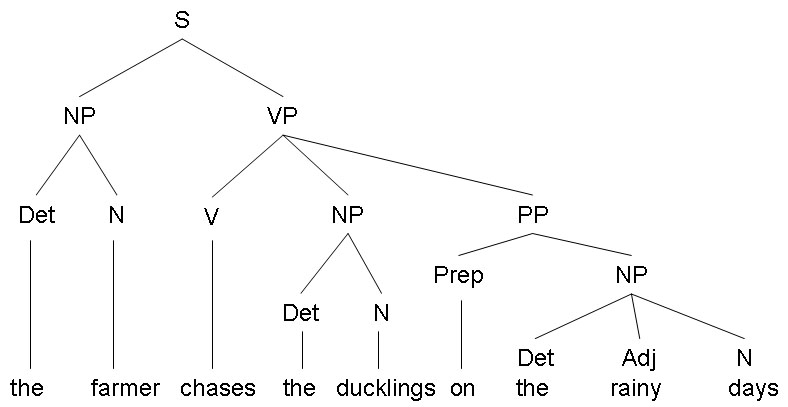
The other tree (see part (d) below) is not possible as a representation
of this sentence. This is because it puts the PP underneath
the NP 'the duckling'. It is not then a Circumstance but a modifier
of the duckling. Grammatically and semantically this has completely
different consequences (e.g., try passivising).
(c) You are asked to circle nodes in the tree,
not the words, that correspond to the Subject, Direct Object
and any Circumstances. This is to show that you know what the
tree has to do with the Subject, Direct Object, etc. It is not
enough just to be able to recognise these in the sentence. The
nodes that you have to circle are the [S, NP], i.e., the NP
child node of the S, [VP, NP] and [VP, PP]. This looks as follows:
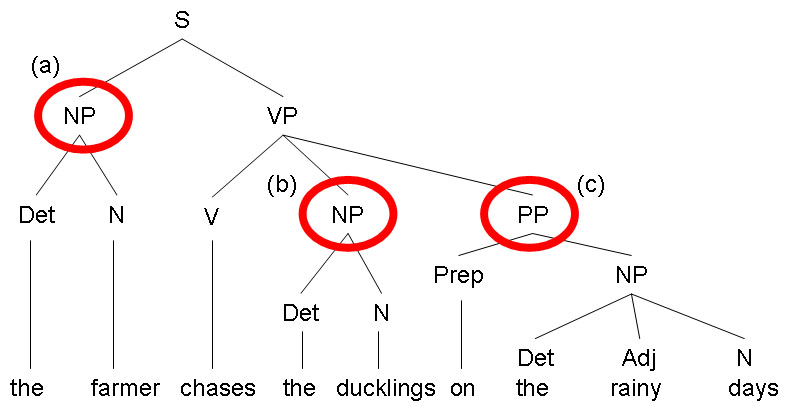
Note that both of the following answers are wrong:
you should know why.
(d) The trees above already show an example of structural ambiguity.
This is where you have the same string of words
but different trees built on top of them. All the trees have
to be allowed by the grammar of course. |
| Q2 |
(a) 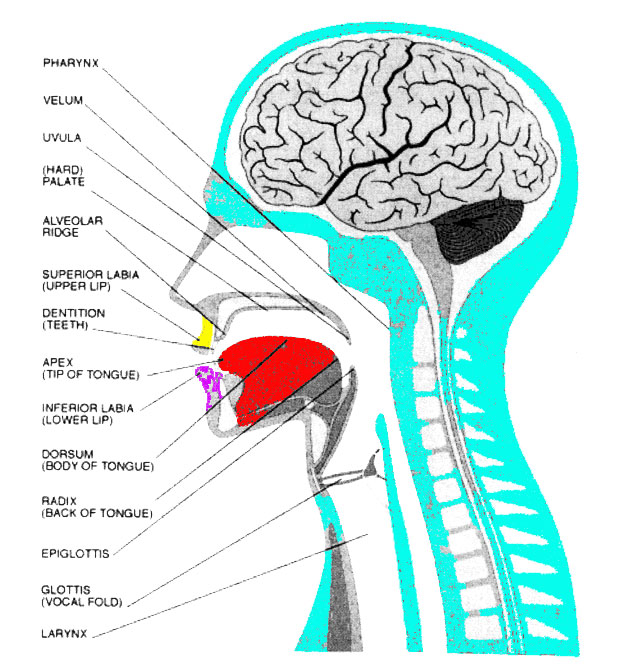 (click for larger view)
(click for larger view)
(b) This question is about formants and acoustic phonetics.
Each vowel has two formants: therefore all answers that just
drew some single line for a vowel were completely wrong. For
each vowel you need to show their two formants. Important here
was to show their relationship to each other, not their precise
values. The dipthong in 'noise' of course needs then four results,
the two formants for the beginning of the vowel and the two
formants at the end of the vowel. This looks as follows:
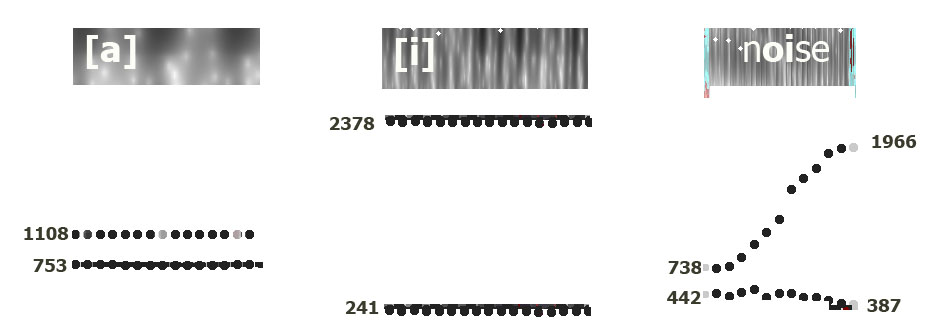
The pure tone is of course just a single straight line, way
below any of the vowel formants. You should
now be able to work out exactly why these patterns come out,
given your notes on phonetics.
(c) The fundamental frequency is the sound made by the vibrating
vocal chords. The fundamental frequencies important for distinguishing
vowels are created by the shape of the mouth, i.e., where you
put the tongue: since that is how you change vowels.
|
| Q3 |
Important here is both to show you know what allophones
and allomorphs are and why they both work quite differently from
each other. Most people remembered that, for example, the phoneme
'l' in English has two common allophones, the clear l and the
dark l, pronounced in different parts of the mouth. For full marks
here you should also have said something about just when one can
occur and when the other can occur. Also many people remembered
that the plural morpheme in English can be expressed phonetically
by an -s, a -z, or an -iz sound. Again for full marks you should
have said something about just when one can occur rather than
the other. Then you could say something about the important difference
between allophones and allomorphs and why we need both. The conditions
for choosing an allophone depend on the phonetic context; the
conditions for choosing between the plural allophones
depend on the fact that a particular morpheme is being expressed.
This cannot be captured purely in terms of phonetics
and so demonstrates that we need allomorphs too, if we are going
to explain what is going on. |
| Q4 |
One possible analysis would be the following:
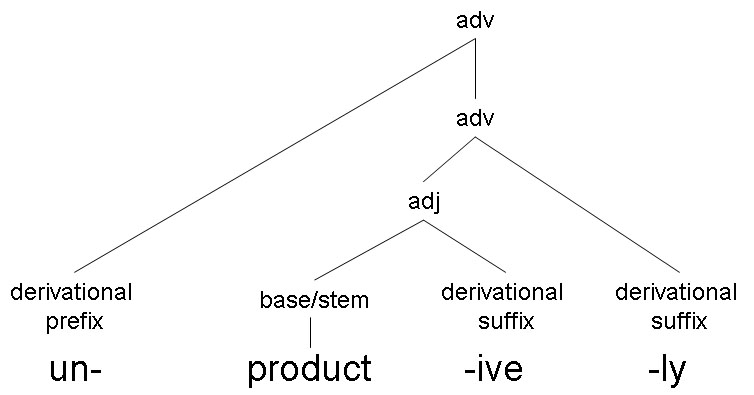
Others are possible, but not any that contain impossible words,
like an 'unproduct'. Note that we might also consider taking
'product' apart, perhaps from 'produce' as verb and some derivational
affix that turns this verb into a noun 't', although this is
not a very productive suffix... All of these affixes are derivational,
because they are not simply indicating grammatical modifications
but are actually changing the word. |
| Q5 |
This was a very easy way to get marks: the dates
did not have to be extremely accurate (apart from the few cases
where there is some easy historical event to latch on to). More
important was getting them in the right order and more or less
into the right centuries or time frame. This would look something
like:

|
| Q6 |
Also an easy way to get points, just filling
in the truthtable as follows:

The observations that you should make here are the fact that
the first implication is always true (a tautology) regardless
of what p and q are, and in the second case the implication
is only true when p and q are identical (i.e., both true or
both false). This latter is then equivalent to an arrow pointing
both ways between p and q. You got partial marks for getting
any of the ands, ors and implications correct systematically;
if there was not recogniseable pattern, then you did not. |
| Q7 |
In the two parts of this question, in the first
you just had to show that you could put together the pieces
of logical formula in order to get some appropriate representation
for the given sentence; in the second part, you had to go further
and show how you could use the syntactic tree as a series of
instructions for how to put together a logical expression: i.e.,
to show compositional semantics in action.
An answer for part one would therefore be something like:

You got a few extra marks if you commented on possible ambiguity,
if you showed that you new what higher and lower scope are,
and if you also knew what scope and ambiguity have to do with
each other.
For the second part, you need to show some connection between
the tree and the growth of the logical form. That would loke
something like:

Here you can see exactly what semantics is associated with
each node in the tree, which is the point of the question. You
got marks if you showed you knew what the individual nodes meant,
and even more marks if you could express this using logic. |
| Q8 |
You should have used the standard definitions of
the terms as given in the reading and class, and knew how these
correspond to logical forms. You obtained marks when these were
applied sensibly: i.e., it was clear you knew what you were writing.
A good example of where some of you were not
clear about what you were writing was when it was not only claimed
that mother-father were converses but the correct
logical form for converses was given. The correct logical form
for converse is P(x,y) <-> Q(y,x). So if you wrote something
like father(x,y) <-> mother(y,x) [as some of you did], you
must also think what does that mean. It means
that you are suggesting that if you are someone's father then
that person is your mother. This is obviously absurd: so, as always,
it is never enough just to write some analysis down (semantic,
syntactic, etc.), you must know what consequences follow
from what you write!!! |
| Q9 |
The correct answers are as follows, with the
following code: Subjects, Participants,
Processes, Circumstances.
- The man in the moon
jumped over the fence
- Once upon a time there
was an old pin
- Sitting around in exams
is dangerous to the health
- On Tuesdays she
used to do yoga.
In addition, 'sitting aoound in exams' is also a clause, consisting
of the following functional constituents:
Subjects, participants, processes and circumstances are all
functional constituents of clauses and only clauses!
This means, for example, that the 'in the moon' in
the first sentence can never be a circumstance
in English: that is not what the sentence means. If you are
not clear about this, make sure you become clear (Sprachpraxis!).
The ambiguities for the second part of the question are as
follows:
- The bad man was given [the book on the table by his
mother].
- The bad man was given the book on
the table by his mother.
- The bad man was given [the book on the table] [by
his mother].
- The bad man was given [the book on the table] by
his mother.
Any more?! |
| Q10 |
This was also straightforward: you had simply to
see what sound changes were occuring in the data on the right
of the question, and to pull out of this a generalisation that
covered all the changes. There were two conditions, one for voiced
plosives (e.g., b and g), and one for unvoiced plosives (k, t).
The fromer loose their voicing, the latter lose their plosiveness
and become fricatives. This is all you needed to write. Further
interpretations in terms of Grimm or anybody else were not necessary.
Since the asked about sound [p] is an unvoiced plosive, you needed
to say that what happens is that after this you have an unvoiced
fricative, preferably a bilabial fricative, but as long as you
got the general direction of the change right, I was not too fussy
(so [f] was also OK for example). |
| Q11 |
For this question the main point was to see if
you could apply what we saw in class and had in the readings to
some data. This again means thinking and not just trying to fit
some text that you have learnt. It also required looking at the
data rather than imposing your presuppositions. Clearly the data
do not represent any known standard variety of English because
the more 'prestigious' form is the one with the glottal stop.
We know this because this is the direction of correction for all
areas examined. This is compatible with area C being the highest
social class. Those of you who put it the other way round were
just not applying what we have learnt and were ignoring the data,
always a good way to get very bad analyses and to miss what is
going on. Those of you who also talked about the special cross-over
role of the middle classes (which is also evident in the data,
because this is where the greated correction occurs) obtained
extra marks. |
|